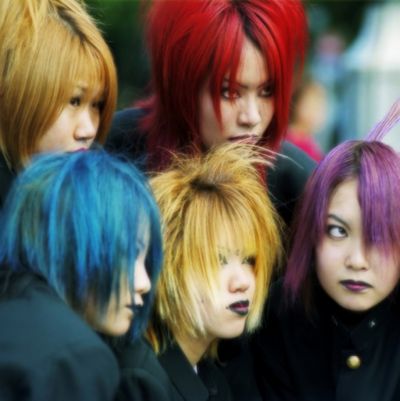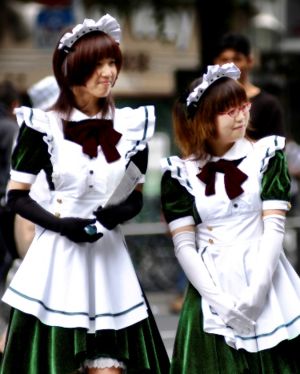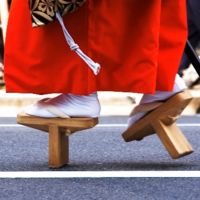Culture of Japan

Photo © by Sonny Santos, used by permission.
The culture of Japan has evolved greatly over the years, from the country's original Jomon culture to contemporary times, which combines influences from Asia and the West. After several waves of immigration from the continent and nearby Pacific islands (see History of Japan), followed by a heavy importation of Chinese culture, the inhabitants of Japan experienced a long period of relative isolation from the outside world under the Tokugawa shogunate, until the arrival of the 'Black Ships' and the Meiji era. As a result, a culture distinctively different from other Asian cultures developed, and echoes of this persist in Japan today.
Japanese language
The Japanese language has always played a significant role in Japanese culture. Spoken mainly in Japan and by some Japanese communities around the world, it is an agglutinative language - grammatical units link together in long 'strings' to make words[1] - and its 'sounds' consist mainly of consonant-vowel units that cannot be split up, such as bu, ni and ka (see Japanese phonology). The language also makes use of pitch rather than stress to distinguish many words.
Early Japanese is known largely on the basis of its state in the eighth century, when the three major works of Old Japanese were compiled. The earliest attestation of Japanese is in a Chinese document from 252 AD.
The Japanese language is written with a combination of three different scripts. Chinese characters (漢字 kanji) are used for the most meaningful words such as most nouns and verbs; these take some time to learn. Two further scripts, hiragana (ひらがな) and katakana (カタカナ) write moras, equivalent to but not the same as syllables, and to a degree can indicate pronunciation. The Latin alphabet, rōmaji (ローマ字), is also often used in modern Japanese. These are used for different purposes (see Japanese language - Writing system). The Hindu-Arabic numerals are generally used for numbers, but traditional Sino-Japanese numerals are also commonplace.

Photo © by Sonny Santos, used by permission.
Visual arts
Painting
Painting has been an art in Japan for a very long time: the brush is a traditional writing tool, and the extension of that to its use as an artist's tool was probably natural. Native Japanese painting techniques are still in use today, as well as techniques adopted from continental Asia and from the West.
Calligraphy
The flowing, brush-drawn Japanese language lends itself to complicated calligraphy. As in other East Asian countries, the rendering of text itself is seen as a traditional artform as well as a means of conveying written information. The art can consist of phrases, poems, stories, or even single characters. The style and format of the writing can mimic the subject matter, even to the point of texture and stroke speed. The creation of the calligraphy is considered as much an art as the pictures themselves, and it can take over one hundred repetitions to produce the desired effect of a single character. Calligraphic art is often too obscure for Western audiences, and general exposure is very limited.
This art form is known as Sumi-e and involves making ink by grinding a solid ink stick on a special stone, and mixing it with water.
Sculpture
Traditionally, Japanese sculpting techniques were derived from Buddhist and Shinto traditions. Wood, often lacquered, gilded, or brightly painted, is the most common traditional sculpting material. Bronze and other metals are also important. Other materials, such as stone and pottery, have had extremely important roles in the history of Japanese sculpture.
Ukiyo-e
Ukiyoe (浮世絵), literally 'pictures of the floating world') is a genre of woodblock prints that exemplifies the characteristics of pre-Meiji Japanese art. Because these prints could be mass-produced, they were available to a wide cross-section of the Japanese populace — those not wealthy enough to afford original paintings — during their heyday, from the 17th to 20th century.
The widespread popularity of ukiyo-e prints lead to their recognition as a very Japanese artform, which in turn has led to significant modern mimicry of ukiyo-e stylings in advertisements, posters, and other art including manga.
Ikebana
Ikebana (活花) is the art of Japanese flower arranging. It has gained widespread international fame for its focus on harmony, color use, rhythm, and elegantly simple design. It is an art centered greatly on expressing the seasons, and is meant to act as a symbol to something greater than the flower itself. Many Japanese women entering into a third party marriage learn Ikebana to be a more appealing and well-rounded lady. Ikebana is widely practiced in Japan today, as well as around the world.
Performing arts
Mention Kabuki, Noh, Takurazuka, and Bunraku.
Architecture
Japanese architecture has as long a history as any other aspect of Japanese culture. Originally heavily influenced by Chinese architecture, it also develops many differences and aspects which are indigenous to Japan. Examples of traditional architecture are seen at Temples, Shinto shrines and castles in Kyoto and Nara. Some of these buildings are usually constructed with traditional gardens, which are influenced from Zen ideas.
Some modern architects, such as Yoshio Taniguchi and Tadao Ando are known for their amalgamation of two different ideas, Japanese traditional architecture and Western one.
Clothing
- See also: Geta
The Japanese word kimono(着物) means 'something one wears'; it is a traditional garment of Japan. Originally, the word kimono was used for all types of clothing, but eventually, it came to refer specifically to the full-length garment also known as the nagagi, meaning 'long-wear', that is still worn today on special occasions by women, men, and children. It is often known as wafuku, which means 'Japanese clothes'. Kimono come in a variety of colours, styles, and sizes. Men mainly wear darker or more muted colours, while women tend to wear brighter colours and pastels, and often with complicated abstract or floral patterns. The summer kimono, which are lighter, are called yukata. Formal kimono are typically worn in several layers, with number of layers, visibility of layers, sleeve length, and choice of pattern dictated by social status and the occasion for which the kimono is worn.
Cuisine
Through a long culinary past, the Japanese have developed a sophisticated and refined cuisine highly sensitive to the change of seasons. Modern Japanese enjoy a variety of traditional Japanese food, including the staples of rice and miso soup, as well as many seafood dishes (sushi and sashimi for instance), and a multitude of foreign dishes. One can easily find Chinese, Korean, and Thai dishes as well as non-regional American, French, and Italian foods. Japanese cuisine is a product of its environment and people. The ease of acquiring fresh ingredients led to sushi, high temperature and humidity led to varieties of pickled and fermented food like natto and soy sauce, and adaptation of foreign cuisines led to ramen, which originated in China, and other forms of noodles such as soba.
Sports
Popular professional sports in Japan can be categorized into either traditional sports like Sumo wrestling or imported sports like baseball and football (soccer). In addition, many amateur sports are popular in Japan, such as table tennis, tennis, volleyball, basketball, golf, and rugby. Popular amateur sports native to Japan include Japanese martial arts such as kendo and judo. Professional wrestling, or puroresu, is also very popular in Japan.
Popular culture

Photo © by Sonny Santos, used by permission.
Japanese popular culture not only reflects the attitudes and concerns of the present but also provides a link to the past. Popular films, television programs, comics, and music all developed from older artistic and literary traditions, and many of their themes and styles of presentation can be traced to traditional art forms. Contemporary forms of popular culture, much like the traditional forms, provide not only entertainment but also an escape for the contemporary Japanese from the problems of an industrial world. When asked how they spent their leisure time, 80 percent of a sample of men and women surveyed by the government in 1986 said they averaged about two and one-half hours per weekday watching television, listening to the radio, and reading newspapers or magazines. Some 16 percent spent an average of two and one-quarter hours a day engaged in hobbies or amusements. Others spent leisure time participating in sports, socializing, and personal study. Teenagers and retired people reported more time spent on all of these activities than did other groups.
In the late 1980s, the family was the focus of leisure activities, such as excursions to parks or shopping districts. Although Japan is often thought of as a hard-working society with little time for pleasure, the Japanese seek entertainment wherever they can. It is common to see Japanese commuters riding the train to work, enjoying their favorite manga or listening through earphones to the latest in popular music on portable music players.
A wide variety of types of popular entertainment are available. There is a large selection of music, films, and the products of a huge comic book industry, among other forms of entertainment, from which to choose. Game centers, bowling alleys, and karaoke are popular hangout places for teens while older people may play shogi or go in specialized parlors.
Nihonjinron
The Japanese culture is often perceived as "uniquely unique". This leads to the widespread application of cultural "us" and "them" studies of Japan, in which Japanese culture is placed next to Western culture (particularly the culture of the United States, rather than considered independently). Such studies have a tendency to overstate the importance of certain aspects of Japanese culture, as they are particularly foreign to a Western ethnocentric observer, and gloss over vital parts of the Japanese culture as they are not remarkable from an ethnocentric perspective.
Among the founding works in modern Japan studies (and of Nihonjinron), and one of the foremost comparative cultural studies of Japan, is the 1945 book The Chrysanthemum and the Sword, Ruth Benedict proposed that Japan has a shame culture (external reference standard) rather than the guilt culture (internal reference standard) that is common in the West. According to Benedict, inter-relationships between people are heavily influenced by concepts of "honor", "obligation", and "duty" in a way that is much less true in the more individualistic West. Finally, The Chrysanthemum and the Sword asserts that generalized conceptions of morality and desirable behavior are less developed in Japan, where particular and situational obligations to family, school, and friends tend to guide behavior.
Footnotes
- ↑ Example: tabetakunakatta - tabe 'eat', -ta- 'want', -kuna- 'negative', -katta 'past' - i.e. 'did not want to eat'.
